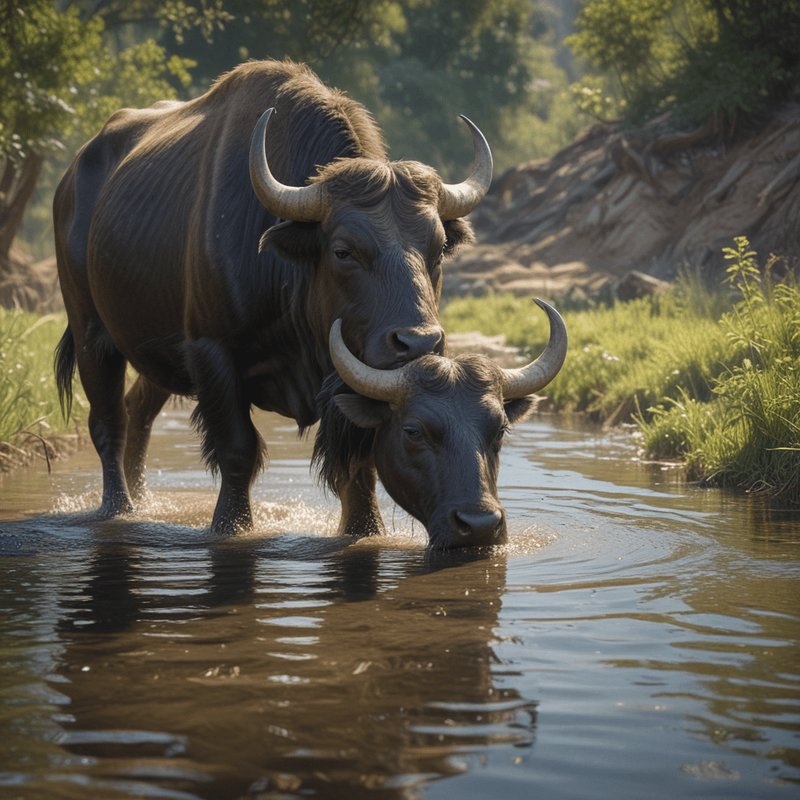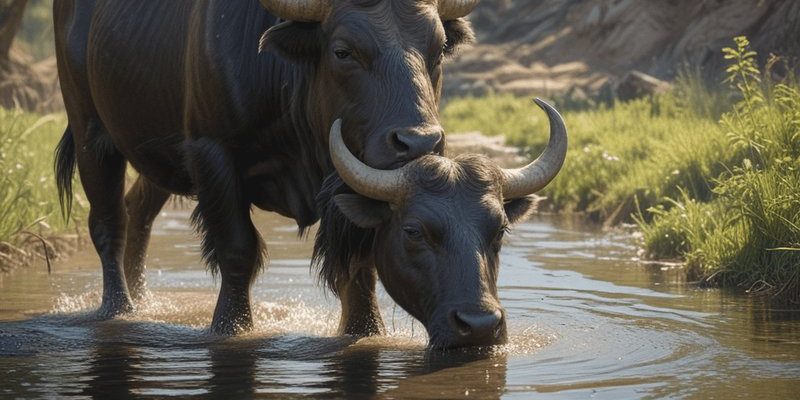
Just like how some people think all cats hate water, water buffalo often get mischaracterized too. For instance, many folks believe they are just simple farm animals, but in reality, they are much more complex. Let’s dive into the common myths surrounding these impressive creatures and uncover the truth.
1. Water Buffalo Are Only Found in Water
You might have heard that water buffalo spend most of their time submerged in water, and while it’s true that they love to cool off in ponds or swamps, this notion paints an incomplete picture. Water buffalo are highly adaptable animals. They can thrive in various environments, from rice paddies to grasslands and even dry, arid regions.
Many people assume that if there isn’t water nearby, you won’t find them. However, water buffalo are quite capable of foraging for food and finding shelter away from water sources. They do enjoy wallowing in mud to regulate their body temperature and protect their skin from sunburn and insects, but they are not exclusively aquatic animals.
In fact, they’re often found grazing in fields, enjoying a diet of grass, hay, and other plants. So, while they may love to cool off in water, they are not solely aquatic creatures.
2. Water Buffalo Are Lazy
Another common myth is that water buffalo are lazy animals, just lounging about all day. In reality, they are hardworking and incredibly useful to farmers around the world. These animals have been domesticated for thousands of years, and their strength has been harnessed to pull plows and carts, especially in rice farming.
You might be surprised to learn that water buffalo can pull heavy loads and work long hours in the fields. They are often referred to as the “beasts of burden” in agricultural settings. Their strength and endurance make them invaluable to farmers, particularly in places where machinery is less accessible.
The idea that they’re lazy often stems from the way they relax in water or mud. But take a closer look, and you’ll see that they’re simply enjoying their downtime. Just like us, they need to take a break after a hard day’s work!
3. All Water Buffalo Are the Same
Not all water buffalo are created equal! There are actually two main types: the River Buffalo and the Swamp Buffalo. Each type has distinct characteristics and is suited to different environments.
The River Buffalo, with its large horns and sleek body, is often found in more temperate regions and is known for its dairy production. On the other hand, the Swamp Buffalo has a stockier build and is better suited for wet, swampy areas. It’s particularly well-adapted for rice farming in Southeast Asia, where it thrives in muddy fields.
Understanding these differences is essential, especially for farmers who might choose one type over another based on their specific needs. So, when people say all water buffalo are the same, remind them there’s a bit more to the story!
4. Water Buffalo Milk Is Just Like Cow’s Milk
You might think that since both water buffalo and cows provide milk, their milk is pretty similar. Here’s the thing: water buffalo milk is actually quite different! In fact, it’s richer and creamier than cow’s milk, with a higher fat content.
This creamy milk is popular in various cultures and is often used to make delicious cheeses like mozzarella. It has a unique flavor that’s beloved in regions where water buffalo are raised. So, if you haven’t tried it yet, you might be missing out on something special!
Water buffalo milk is also known for its nutritional benefits, being high in protein, calcium, and vitamins. So, the next time you’re at the grocery store and see water buffalo milk, do give it a try!
5. Water Buffalo Are Aggressive Animals
It’s a common misconception that water buffalo are aggressive, but let’s clear that up. Like any animal, their behavior largely depends on their treatment and environment. Water buffalo are generally gentle and docile creatures, particularly when they are handled with care and respect.
They can be protective of their young, just like many animals, and might display aggressive behavior if they feel threatened. However, when raised in a calm and positive environment, these animals can be friendly and even sociable with humans. Many farmers build strong bonds with their water buffalo, treating them more like companions than mere livestock.
So, if you hear someone say that water buffalo are always aggressive, you can confidently offer the perspective that a little kindness goes a long way.
6. Water Buffalo Can’t Survive in Cold Weather
You might think that water buffalo can only thrive in warm climates, given their love for water and mud. While they do prefer warmer conditions, they are surprisingly resilient. Some breeds of water buffalo have adapted to survive in cold or temperate regions.
For instance, in places like Italy and parts of Eastern Europe, water buffalo are raised in colder climates. They can handle chilly temperatures better than you might expect, especially when provided with proper shelter and care. It’s all about making sure they have a warm, dry place to stay during the winter months.
So, while they’re often associated with hot, humid environments, don’t underestimate their ability to adapt to different weather conditions!
7. Water Buffalo Are Endangered
Lastly, let’s address the myth that all water buffalo are endangered. While some wild populations face threats due to habitat loss and hunting, domesticated water buffalo are not considered endangered. In fact, they’re quite common in agricultural settings across the globe.
However, it is essential to note that certain breeds might be at risk due to factors like declining agricultural practices and the rise of machinery. Conservation efforts are in place to protect vulnerable populations and promote sustainable farming practices that include water buffalo.
So, while the wild relatives might be struggling, the domesticated versions aren’t going anywhere anytime soon—at least not if we treat them right!
In conclusion, water buffalo are fascinating creatures often surrounded by myths and misconceptions. They’re not just muddy creatures that need water; they are hardworking animals with distinct varieties, rich milk, and gentle natures. Understanding the truth about them can lead to greater admiration and respect for these incredible animals. Next time you think about water buffalo, remember their true story!

